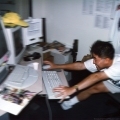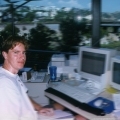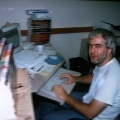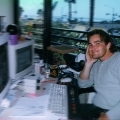The making and remaking of The Journeyman Project: Pegasus Prime
First posted on 27 March 2013. Last updated on 27 March 2013.
About the interviews
The interviews with Geno Andrews, Bob Bell, Connie Cragel LePere, Eric Dallaire, Jack Davis, Leif Einarsson, Matthew Hoops, Keith Kaisershot, Tim Tembreull, and Tommy Yune of Presto Studios were originally conducted between July and November 2012. Their assistance in the preparation of this article, including access to previously unreleased materials from Presto Studios, was greatly appreciated.
For more information on The Journeyman Project: Pegasus Prime, visit The Journeyman Project Trilogy.
The original release of The Journeyman Project was put together by a group of friends and colleagues assembled by Michel Kripalani (cofounder of Presto Studios), some of whom knew each other since childhood. They worked unpaid on the game, living and working together in a residential house in a cul-de-sac. Many of them passed on traditionally paying day jobs. Everybody contributed to the project on an equal basis. Changes to the game happened weekly as ideas flowed or as new technology became available—underwater sound effects were simulated by recording with a microphone submerged in bath tubs of water, and shadows for rendered models were edited into each scene by hand—whatever it took to get the game done. It was a memorable time for all who were involved. It was a dream time.
Geno Andrews (Figure 1), composer for The Journeyman Project, recalled,
"I look back on that time like you look back on a great relationship that didn't last forever, but the experiences changed you profoundly and as a result you'd never change a thing looking back. Most of the whole experience was fantastic. Especially from the creative standpoint. We fit well together. Each pulling his equal weight for equal pay. (Which was nothing at the beginning.)"
The Journeyman Project broke new grounds in game development, pioneered the use of CD-ROM as an interactive medium, and was well received by both critics and fans. After the game's release in 1993, work soon began on the sequel Buried in Time (The Journeyman Project 2: Buried in Time). At the same time, work also started on what later became Pegasus Prime (The Journeyman Project: Pegasus Prime), a complete remake of The Journeyman Project.
The birth of a remake
The original version of The Journeyman Project was implemented using Macromind (later Macromedia and now Adobe) Director, which began to show its limitations as interactive games grew more complex. In response to player feedback, particularly about game performance, Presto Studios released an enhanced version of the game dubbed The Journeyman Project Turbo! in 1994, advertising it to be 300% faster than the original. The strategy of the publisher, Sanctuary Woods, was to sell the new version at a deep discount, to include it in cheap "shovelware" game compilations, and to bundle it with name brand PC compatible computers such as Packard Bell. This strategy paid dividends as the installed user base of the new version swelled beyond that of the original version, eventually helping to drive brisk sales of subsequent sequels as the popularity of the series grew.
The Journeyman Project Turbo! did not, however, change the gameplay in the original version. It just ran faster. Jack Davis (Figure 2), who subsequently led the development team that created Pegasus Prime, had the vision of a Director's Cut of the original game. This new version would include features dropped from the original version. Tommy Yune (Figure 3) also wanted to increase the immersiveness of the original version by having many more animations and improving the graphics. Technology was evolving rapidly: memory sizes were no longer less than a megabyte, and graphic resolutions were improving. Leif Einarsson (Figure 4) was brought in from the development team for Buried in Time to extend and add more detail to the 3D environments originally modeled by Jose Albanil. As well, a move was made from using Swivel 3D to FormZ to handle 3D models.
At the time, it also made business sense for Presto Studios to remake the original game to rejuvenate interest in the series. The story was good, offering plenty of scope and interest for the player to get involved in the game. Being the first game of the series, it was important that the remake matched to the other games in the series in appearance and interactivity. Professional actors were being used in Buried in Time, so it made sense that the same be used in the remake.
What sold the idea of developing a Director's Cut to the management at Presto Studios was the pitch of releasing it quickly for upcoming gaming platforms. "Why not take the game we just finished, update the artwork and gameplay a bit, and get it out on these new platforms?" ran the thinking. In particular, Apple and Bandai were developing a game console called the Pippin, which Presto Studios decided to target along with the PlayStation, Saturn, and 3DO game consoles. Looking back, the platforms might have been the reason why Pegasus Prime came to existence, but they were also the reason why Pegasus Prime ran into a lot of problems and ended with only a limited release. Oddly missing from the target platforms was Windows.
Nobody at Presto Studios anticipated how long this journey was going to take and how difficult it was going to be. As The Journeyman Project Turbo! slowly evolved into Pegasus Prime, what was once minor tweaks to address player feedback eventually became a full-blown remake of all elements of the game except for the sound and plot.
The making of Pegasus Prime
Davis persuaded the management at Presto Studios to let him open a subsidiary office called Presto West in Cardiff-by-the-sea near San Diego. This was so much by the sea that stones could be thrown into the sea from the car park. Davis also liked surfing there. Conveniently, there was a dive bar nearby named the Kraken. Back then, rendering graphics on the slow hardware involved a lot of waiting. So, Tim Tembreull (Figure 5) would press the button to start rendering in After Effects, Kory Jones would press the button to start rendering in Electric Image, and then they all head off for an all-night game of pool in the dive bar.
Bob Bell (Figure 6) was hired to write the implementation of the game for the Mac in C++ to improve speed. The game engine he programmed was composed of different layers: MMShell which drew graphics and played sounds, Game Shell which provided generic game logic and understood locations and inventory items, and JMP layer which managed custom code for puzzles like the Mars reactor. All of the drawing was done in software, so to achieve acceptable frame rates, he had to make sure that the code was optimized to draw as few pixels as possible and to avoid unnecessarily drawing to the same pixel more than once on the screen.
Bell also developed a smart utility called World Builder. It combined lots of video sequences into a single large movie in QuickTime with lookup tables. Doing that way meant that the game could keep the movie open and just seek to frames in it, avoiding the overhead of opening individual smaller movies. Patrick Rogers coordinated the media files being compiled into World Builder, while Lauren Morimoto supervised the localization of the assets for the Japanese version of the game. Bob Stewart (Figure 7), composer for Buried in Time, added music and audio cues to Andrews' existing soundtrack to round out the gameplay environments that had been greatly expanded in Pegasus Prime.
Bell recalled,
"I was really proud of World Builder. In some ways, it was as much fun to work on that as on the game itself!One of the things that made the Pegasus Prime project so exciting to me was that it was a convergence of my two great professional loves: computers and storytelling. Games like Pegasus Prime were really interactive stories."
Einarsson also recalled,
"Every night, as soon as the sun would go down and Jack left the parking lot, the five of us would turn our machines into LAN gaming centers and play "Marathon" against each other. This was a serious addiction, where we would race for weapons and hide behind teleporters stalking each other."
Bell faced steep challenges in making the remake work on the Pippin. The Pippin had limited memory. When the Pippin displayed the game on the television, the colors could be rather different compared to the Mac. There was no hardware acceleration for graphics. As well, deploying a build of the game to the Pippin was not a simple deal. A CD had to be burned with the operating system on it, and the Pippin had to be booted from it. There was no way to debug on the Pippin. The team had to just guess what had gone wrong from what was being displayed. There was no emulator. The system software kept changing as Apple was developing the Pippin.
David Black wrote his own code to implement the game for the PlayStation. Unlike the Mac, the PlayStation did not use QuickTime. As such, he had to write his own media playback system based on Sony's proprietary MDEC codec and modify it to support 24-bit color because the software development kit at the time was still limited to 16-bit color. Happily or not, plans to port the game to both the Saturn and the 3DO were dropped early on. Even so, the limitations of the consoles, particularly the Pippin, meant that Davis' initial design had to be pruned back substantially. For instance, the submarine chase in the Norad segment that was originally planned was not possible, so the interactive sequence was instead substituted by a cut scene. As well, the video sequences for the console versions were encoded with a resolution of 320x240 pixels in order to reduce the amount of disc swapping as the game was no longer able to fit on a single CD.
The story for Pegasus Prime did not really change from that for the original version of The Journeyman Project. Still, there were some minor changes as a result of how the series mythos was subsequently developed. Eric Dallaire (Figure 8), who wrote the story for Legacy of Time (The Journeyman Project 3: Legacy of Time), had written Elliot Sinclair and the Cyrollans to be more complex characters. So, when he did the spot editing for Pegasus Prime, he inserted subtle hints into the game that foreshadowed the evolution of these characters in Legacy of Time.
Dallaire remembered,
"Over my five years there (at Presto Studios), it was the best working environment you could think of with some of the craziest talented people -- most of which have gone on to amazing careers (Pixar, Electronic Arts, Activision, Dreamworks, Oceanhouse Media, just to name a few). But more specifically I remember lots of late night design sessions with Tommy Yune, especially hiding all the easter eggs in the game. We worked hard together, played games together (many Starcraft sessions), and hung out together. Buying the pool table off Kory Jones (Figure 9), lead animator of Pegasus Prime, and using it primarily as a game table to play lots of Settlers of Catan. Being on the set with Jack for the reshoots and the dialogue recording was a lot of fun. Occasionally, since it's a small world, I get to work with some of those old Prestonians and it's always a thrill because I always walk away smarter for the experience."
For the main roles in Pegasus Prime, Presto Studios hired Hollywood stars Graham Jarvis and Michele Scarabelli to play the characters Elliot Sinclair and Michele Visard, respectively. Davis also contacted the Lamb's Players Theatre Company, a highly regarded stage ensemble based in San Diego, for actors to fill other smaller roles. Connie Cragel LePere (Figure 10) leapt at the chance to do some acting off stage by playing the characters Megan Love and Dr. White.
LePere recalled,
"I remember filming the Megan Love sections most of all. I had forgotten about Dr. White until recently when I was emailed a photo of me playing that character! Too funny seeing that after all these years! I remember filming in front of the green screen and trying to imagine the futuristic setting I was "in" at that moment. I recall someone involved from the project asking me if I "minded" the name Megan Love. I didn't follow and he could tell. So he repeated it for me slowly...ahhhh! Then I heard it. I blushed for being so slow on the uptake and then because of the double meaning of my character's name! They were incredibly nice, fun, patient - the whole Journeyman Project experience remains one of the best acting projects of my life!"
Coming down to earth
By 1997, the development of Pegasus Prime was being seriously affected by problems outside Presto Studios. The first intended publisher for the Mac version of the game was Sanctuary Woods. Unfortunately, the company was beset with financial difficulties and eventually filed for bankruptcy in 1999. Bandai subsequently picked up the publishing rights for the Mac, allowing Presto Studios to recoup some of the game's development costs spent on developing for the Pippin.
In the end, the Pippin was a failed experiment. In fact, Apple was in dire straits financially before Steve Jobs returned to the company. Apple, together with Bandai, even tried ideas like deploying the Pippin into vertical markets like kiosks to try to recover some of the console's development costs. Eventually, the Pippin got cancelled.
Despite going to golden master, the PlayStation version of the game never made it to market in the United States, as the publisher Acclaim Entertainment had also experienced financial difficulties and did not release the game.
Ironically, both Buried of Time and Legacy of Time were selling very well on the PC. A PC version of Pegasus Prime would have attracted sales. Alas, unlike the other platforms which Presto Studios had expended so much resources on developing, the company had not released the game for the PC.
Falling into obscurity
With only a limited release, Pegasus Prime fell into obscurity. It might have had a release on DVD-ROM. Bell had implemented a single disk version of the game to avoid disk swapping, intended to simplify the testing process for himself before shipping the game. Yune, who by then was working on Legacy of Time, looked to DVD-ROM as the format to supplant CD-ROM with its expanded bandwidth and storage capabilities. In fact, a DVD-ROM version of the game was prepared after the release of CD-ROM version of Pegasus Prime in 1997, but the format was still too new for Bandai to consider releasing it.
Legacy of Time ended up becoming the first DVD-ROM software title released for the Mac in 1998, after Jobs (now back at Apple) unveiled the new Powerbook G3 with built-in DVD-ROM drive just months earlier. Yune had hoped the DVD-ROM version of Pegasus Prime would soon see a release, but the game was no longer compatible with the new operating system as Apple retired the classic Mac OS 9 in 2002. Pegasus Prime had originally been touted as a game that embraced Apple's "Accelerated for PowerPC" platform from the ground up, but the Mac OS X operating system phased out support for older processors by deprecating transitional technologies such as Carbon and Rosetta.
Despite Pegasus Prime's relative obscurity, Presto Studios gained valuable user interface design experience from the game's development. The original version of The Journeyman Project could be forgiven for the overuse of bells and whistles in the game's user interface, as it was a time when many developers were experimenting with in the early era of the CD-ROM media. However, Buried in Time's extraordinary gameplay design was also somewhat held back by a clunky user interface. For the console version of Pegasus Prime, the user interface had to be simplified so that it was out of the way of the player, especially with handheld controllers. Because the Mac version of Pegasus Prime was originally designed for use around the Pippin's D-pad controller, the user inputs were centered around the direction keys. This user interface was extended into the PlayStation version of Buried in Time, which evolved into the streamlined interface used in Legacy in Time.
The remaking of Pegasus Prime
In 2005, an avid fan named Keith Kaisershot embarked on a real labor of love, after graduating high school, to try to remake Pegasus Prime. By just seeing what the game did and by reverse engineering the game's data files, he tried to rewrite the game engine used in Pegasus Prime from scratch. He got as far as the game's main menu, which by itself was a major achievement. A few years later, another fan named Matthew Hoops contacted Kaisershot about the fan project. Together, they worked to try to decode the format used to store the game's data. However, without the source code, the initial endeavor was unsuccessful.
After Presto Studios closed its development studio in 2002, Yune continued to maintain an online archive of the company's website. Through this website and also a fan community on Facebook originating at the University of Illinois, Yune came into contact with Kaisershot and Hoops about their work. In 2011, Yune met with Hoops and then persuaded the remaining management at Presto Studios to make available the previously unreleased DVD game assets and source code for Pegasus Prime from the company vaults.
Leveraging this unprecedented opportunity, and relying on his programming experience with ScummVM, Hoops started work on using ScummVM to implement Pegasus Prime for the PC to play on modern computers. The game assets and source code made it possible to decipher how the game stored its data. Kaisershot joined in to refresh the game's code for Mac OS 9, which was a challenge as there was not much official documentation still available.
Here and now
Against all the odds, Pegasus Prime will finally be available for the first time to play on the PC. The game's unlikely resurrection has brought in many benefits. The soundtrack is of better quality, using sources like the unreleased US PlayStation version for Andrews' and Stewart's original music. Many of the sound files sampled at 22KHz have been replaced with files sampled at 44KHz. The cut scenes from the DVD version have been re-rendered at their full original resolution in higher bitrates, eliminating the pixelization that plagued the CD-ROM version. Lastly, some previously cut or unfinished interactive sequences (including Easter eggs) have now been restored.
Bell praised the remake of Pegasus Prime,
"I've been playing with the builds that Keith and Matthew have been putting out, and they are fantastic. It's amazing how it performs exactly like the original version (warts and all!). They've done a tremendous job and I for one am in awe of those guys. I definitely owe them a beer!"
Tembreull said,
"Watching what my son can put together on an iPad and upload instantly to YouTube is incredible compared to what we working with back then and I am thrilled that it keeps improving year after year. On the other hand, the word Cinepak still sends a shiver down my spine."
Davis said,
"Any of you guys hear this who brought it back to life, recoded using your fingernails and scotch tape and duct tape and paper clips to get this to work "Thank you" because it's a baby we're very proud of and it would not be seeing the light of day without a huge amount of talent all round the country including the original Presto crew (Figure 11)."
In return, Hoops said,
"I really just have to say how supportive the Presto guys have been, especially Tommy who I've been in contact with very often over the past year and a half. Bob's wealth of knowledge on the code was beyond helpful and Keith was instrumental in figuring out the game formats."
Finally, Kaisershot commented on his experience working with Hoops on the remake,
"Working with Matt has been an absolute pleasure on this project. I have a lot of respect for his determination to find correct solutions and do things the Right Way, instead of resorting to half-hearted shortcuts. His thorough knowledge of the ScummVM engine has allowed him to take some of my patches and reimplement them in ways more elegant than I thought was possible with that codebase. There have been a few rendering problems where Tommy has offered to doctor the assets to work around the issue, but both Matt and I always go for the "Gandhi bonus" rather than a quick-and-dirty solution."










